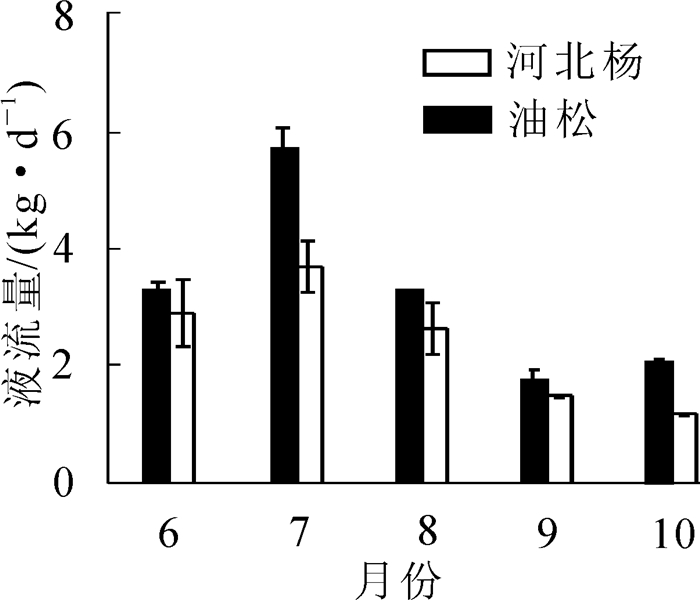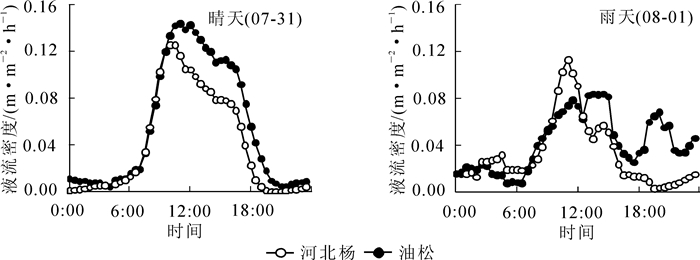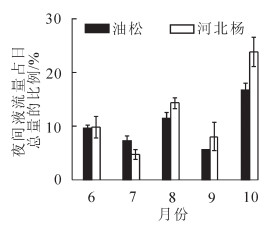-
土壤水分是黄土丘陵沟壑区植被恢复的主要限制因子,水分亏缺会导致植物生长衰退甚至死亡等变化[1-5]。尽管通常认为该区植物是耐旱的,但是黄土丘陵沟壑区自然条件严酷,生态系统脆弱,加上极端干旱事件和全区域干旱天气的增加,必然会引起一系列严重的生态环境问题[5-6]。因此,基于当前水资源利用的矛盾[7],需要全面了解主要造林树种的耗水特性。河北杨Populus hopeiensis是陕北黄土丘陵区的乡土树种,是杨属Populus中相对耐旱、耐瘠薄,能“上山”的树种之一,在当地绿化造林及维持生态系统的稳定性中发挥着重要的作用[8-9]。油松Pinus tabulaeformis是黄土丘陵区的常见造林树种,被广泛应用于“三北”(东北、华北、西北)防护林、退耕还林工程等造林过程中。但陕北地区水资源供需不平衡,存在大量生长缓慢的油松[7, 10]。所以,有必要对河北杨和油松在黄土丘陵区的环境适应性及蒸腾耗水特性展开研究。国内外相关研究表明,通过测定树干液流可以较准确地估算植物蒸腾耗水量,而热技术法是测量乔木个体蒸腾耗水规律的主要方法,其中Granier热扩散探针法以其简单高效的特点得到广泛的应用[3, 7, 9, 11]。周海光等[9]利用热扩散法研究了黄土丘陵沟壑区河北杨,小叶杨Populus simonii和山杏Armeniaca sibirica的树干液流变化规律,万艳芳等[12]利用热扩散法研究青海云杉Picea crassifolia树干液流密度变化特征及其影响因素。上述研究发现:植物为满足自身水分平衡,因根压作用会在夜间产生液流活动,张涵丹等[7]和温杰等[13]的研究也表明:油松普遍存在夜间液流活动。夜间液流广泛存在植物生命活动中,具有促进早晨碳固定、营养供给、补充水分亏缺等重要的生理及生态意义,可能是揭示树木抗旱机制的一种重要现象[14]。相关研究表明:树干液流除了能直观监测植物的蒸腾耗水过程,还能揭示树木生长变化[1, 3]。观测发现:树干液流活动和生长变化的耦合关系是植物在水分亏缺条件下的综合反应[3, 15]。如对挪威云杉Picea abies[16-17],胡杨Populus euphratica[18],华北落叶松Larix principis-rupprechtii[19]的研究表明:树木蒸腾作用强度的日变化引起树干组织水分的减少和增加,会导致树干收缩和膨胀的变化。鉴于此,本研究选取陕北半干旱区典型树种河北杨和油松为研究对象,采用热扩散式探针法,研究河北杨和油松树干液流动态变化特征及其对环境因子的响应关系,并分析树干液流密度与树干茎周长的关系,旨在揭示液流活动对外界环境因子的响应规律,增加对黄土丘陵区人工林水分利用策略的理解,为该地区水资源承载力研究和树种选择提供理论依据。
HTML
-
本研究地位于陕西省延安市吴起县退耕还林森林公园大吉沟北京林业大学试验基地(36°54'20"N,108°10'28"E)。吴起县属于黄土高原丘陵沟壑区,海拔为1 233~1 809 m,气候为暖温带大陆性干旱季风气候,日照充足,昼夜温差大。年平均降水量和气温(1957-2013年)分别为464.6 mm和7.8 ℃,降水主要集中在7-9月,无霜期为120~155 d,年均蒸发量为891.23 mm。土壤类型主要为黄绵土。现有林分以人工灌乔木林为主,主要乔木树种有河北杨,油松,刺槐Robinia pseudoacacia和小叶杨等,灌木主要有沙棘Hippophae rhamnoides和柠条Caragana korshinskii等。
试验地为2008年营造的人工油松、河北杨混交林,初植密度为1 400株·hm-2。河北杨是当地乡土树种,油松是主要造林树种,林下植被主要有胡枝子Lespedeza davurica,冰草Agropyron cristatum,草木犀Melilotus officinalis等。试验在林内1块大小为20 m × 20 m,坡向西偏南10°,坡度约为10°,树种立地条件较一致的样地内进行。
-
利用热扩散探针(TDP-10,TDP-30,Dynamax,美国)于2016年6-10月对河北杨和油松人工林进行树干液流的观测。该探针传感器是基于Granier热扩散理论[20-21]。选择生长良好的河北杨2株、油松3株作为观测样木(表 1),将5个探针分别安装在样树离地面1.3 m处。使用DT80数据采集器(Datataker,澳大利亚)设置采样程序记录并存储数据, 数据采样间隔为30 min。使用Granier公式计算树干液流密度。Fd=0.000 119×[(ΔTmax–ΔT)/ΔT]1.231×3 600。其中:Fd是树干液流密度(m3·m-2·h-1),ΔTmax为24 h内无液流时上下探针之间的最大温差值,ΔT为瞬时温差值。依据树干液流密度推算单株单位时间液流量Q(kg·h-1)的计算公式为:Q=Fd×As×103。其中:As为边材面积(m2),根据时间尺度可以换算为日总液流量(kg·d-1)。将1 d中太阳辐射为0时段内的树干液流定义为夜间液流。
测定样树 胸径/cm 树高/m 边材厚度/cm 边材面积/cm2 河北杨1 6.5 7.8 2.3 29.61 河北杨2 7.1 8.5 3.0 36.74 油松1 8.5 4.5 3.3 39.39 油松2 8.6 4.6 3.3 40.49 油松3 5.6 4.2 2.8 21.23 Table 1. Characteristics of the monitored trees
在各样树上紧邻热扩散探针处安装D6树木生长仪(UMS,德国,精度5 μm,工作温度-30~50 ℃,单通道4线桥式应变传感器)。该仪器安装简单,无需破坏树皮或影响树木的生长,可连续、高精度测量树木的茎周长变化。D6树木生长仪由记录器和树木生长应变传感器组成,树木茎周长的变化能直接传递到传感器,瞬时记录树木生长变化对环境影响的反应等。传感器受温度影响小,其与树皮之间有一个特富龙层,可减少传感器和树皮的摩擦,同时也能不受结冰、树脂或结疤的影响。数据记录在另一台DT80数据采集器中。
-
利用生长锥取样计算边材面积。为避免生长锥取样对树体造成破坏,影响液流观测结果,本研究在样树附近选择其他植株进行取样。河北杨由于数量较少,故选择与样树径级较一致的各3株河北杨钻取木芯,取平均值来代替样树的边材厚度。对油松取样发现,其边材厚度与胸径(DBH)之间存在极显著的二次函数关系:y=0.062x2-0.707x+4.482(R2=0.880 3,n=10),其中y为边材厚度(cm);x为油松胸径(cm)。在此基础上计算油松样树的边材面积。距离样地附近的HOBO自动气象观测站记录太阳辐射(W·m-2),气温(℃),降水量(mm),风速(m·s-1)和空气相对湿度(%)等。在各样树下使用HOBO土壤水分传感器(S-SMC-M005,美国)长期测定土壤体积含水量,观测深度为30 cm,数据采样间隔为30 min。
-
使用Excel软件对树干液流等数据进行整理和计算,所有统计分析均采用SPSS 18.0软件完成,作图采用Origin 9.0软件。
1.1. 研究区概况
1.2. 树干液流及茎周长测定
1.3. 边材面积计算及环境因子
1.4. 数据分析
-
目标树种典型晴天的树干液流密度变化(图 1)显示:河北杨液流密度日变化特征以单峰型为主,在黎明前保持极低水平,6:00-8:30树干液流启动,在11:00-15:00达到峰值。7月观测数据显示,液流密度在午间出现短暂下降,导致呈现双峰现象。之后树干液流密度迅速减小,在17:00-21:30达夜间低值水平。各月夜间均存在微弱的液流。图 2显示:生长季中期的6,7和8月液流密度明显高于9和10月,7月白天液流密度明显高于其他月份,且曲线幅度比其余月份宽。日均液流量大小:3.69 kg·d-1(7月)>2.90 kg·d-1(6月)>2.63 kg·d-1(8月)>1.47 kg·d-1(9月)>1.16 kg·d-1(10月)。油松的液流密度在8:30迅速上升,在11:00-15:00达到峰值,结束时间在18:00-22:00,比河北杨晚1 h左右。7月也出现双峰现象,各月存在微弱的夜间液流活动。日均液流量大小分别为5.74 kg·d-1(7月)>3.30 kg·d-1(6月)>3.29 kg·d-1(8月)>2.06 kg·d-1(10月)>1.76 kg·d-1(9月)。
在晴天(7月30日)和雨天(8月1日)的天气下,2种树种的液流变化曲线相似(图 3)。河北杨在晴天和雨天条件下液流密度峰值分别为(0.126 0±0.046 0)和(0.112 8±0.052 0) m3·m-2·h-1;油松液流密度峰值分别为(0.120 3±0.044 0)和(0.099 8±0.016 0) m3·m-2·h-1。晴天白天液流密度明显高于清晨和夜晚,变化幅度大;雨天变化曲线平缓,雨天液流密度峰值出现明显下降。河北杨雨天比晴天下降41.67%,油松下降10.48%。但雨天夜间液流密度较高,可能与白天太阳辐射减少且降雨补充了林下土壤水分有关。
-
观测期间发现2种树种的夜间液流明显,只有在极少数的情况下液流密度为0。6-8月河北杨液流密度低且平稳,凌晨1:00开始逐渐上升,且夜间液流主要发生在后半夜(0:00-6:00),9-10月河北杨夜间液流活动较强。河北杨6-10月夜间液流量占全天总液流量的比例分别为:9.7%,4.8%,14.2%,8.0%和23.8%。观测日平均比例为12.1%。在季节之间没有显著差异。6-8月油松夜间都保持较低液流密度,9和10月波动较大,夜间液流活动明显增强,可能与土壤水分增加有关。6-10月夜间液流量占全天总液流量的比例分别为:9.5%,7.2%,11.4%,5.5%和16.6%。观测日平均比例为10.0%(图 4)。
-
环境因子与河北杨和油松树干液流密度之间的相关分析(表 2)表明:河北杨液流密度与太阳辐射和气温极显著正相关(P<0.01),与风速显著正相关(P<0.05),而与相对湿度极显著负相关(P<0.01),与其他环境因子的相关关系不显著(P>0.05)。对于油松,液流密度与太阳辐射、风度、气温和土壤含水量显著正相关(P<0.01),而与相对湿度和气压显著负相关(P<0.01)。图 5比较了8月典型晴天的液流密度均值在气象因子较一致的情况下对土壤含水量下的响应,表现为土壤含水量从10.7%下降到4.9%导致河北杨液流密度均值减少27.0%,油松减少33.0%。
树种 太阳辐射 风速 气温 相对湿度 气压 土壤含水量 河北杨 0.507** 0.185* 0.295** -0.195** -0.097 -0.032 油松 0.643** 0.487** 0.605** -0.524** -0.280** 0.481** 说明:*和**分别表示该值在P=0.05和P=0.01水平上差异显著 Table 2. Pearson correlation coefficient of the monitored trees sap flow density to environmental factors
由于树体自身存在着巨大的储水性,树体内部的水分消耗能通过树干茎周长变化反映出来。为了分析2种树种茎周长日变化与液流活动的关系,绘制液流密度与茎周长的日变化过程图(图 6)。结果表明:日出前,2种树种存在较弱的夜间液流活动,茎周长表现出微弱的下降。日出之后即太阳辐射开始增强,植物耗水量加大,2种树种液流密度迅速升高,而茎周长却迅速减小。观测发现茎周长变化总的趋势表现为先降低再升高后降低,与液流密度变化规律相反。其次,从表 3发现:2种树种的树干收缩期正好处在液流活动期间内,在整个研究期间均存在这一现象。相关分析表明:2种树种的液流密度与茎周长日变化呈显著负相关关系(河北杨:R2=-0.50,P<0.01;油松:R2=-0.36,P<0.01),说明树木茎周长的日变化与树干液流活动紧密相关。

Figure 6. Diurnal variation of daily sap flow density and daily perimeter variation, solar radiation for Populus hopeiensis and Pinus tabulaeformis
树种 月份 树干收缩时间 树干膨胀时间(至第2天) 液流启止时间 液流降低时间 液流增长时间(第2天) 河北杨 6 6:30-14:30 14:30-7:00 6:00-20:00 14:30-20:00 7:30-10:30 7 10:30-17:00 17:00-10:00 8:30-20:00 10:00-20:00 8:00-10:00 8 8:30-17:00 17:00-5:30 7:00-18:30 15:00-18:30 9:00-12:30 9 7:30-15:30 15:30-8:30 7:30-17:00 14:30-17:00 8:30-15:30 10 8:30-16:30 16:30-6:00 8:00-21:30 12:30-21:30 8:00-14:30 油松 6 9:30-19:30 19:30-7:00 8:30-20:00 15:30-20:00 7:30-10:30 7 10:00-18:00 18:00-10:00 8:30-22:00 11:00-22:00 7:30-13:30 8 9:30-17:00 17:00-5:30 7:00-19:30 15:00-19:30 7:30-13:30 9 7:30-16:30 16:30-8:00 7:00-19:30 13:00-19:30 7:30-13:00 10 11:00-16:00 16:00-10:30 9:00-18:00 14:00-18:00 9:30-13:00 Table 3. Diurnal variation of daily sap flow density and daily perimeter variation for Populus hopeiensi and Pinus tabulaeformis
2.1. 树干液流密度动态变化
2.2. 夜间液流
2.3. 液流密度与环境因子的关系
-
本研究中河北杨和油松的树干液流密度昼夜变化相似,主要呈单峰型曲线,与其他树种一致[12-15, 22-29],差异表现在启动时间、峰值和下降时间的不同。昼夜变化规律是因为树干液流的产生主要是由于蒸腾拉力的作用,影响蒸腾作用强度的因子就会影响树干液流密度,在土壤水分不受限的条件下,液流密度就随着蒸腾强度的增加而升高[22-26]。本研究结果也证实了这一点。6-8月液流密度均值与峰值均较高,与太阳辐射和气温具有较强正相关性。其次,王华田等[24]认为:树木日液流密度最大值可能仅与土壤水分状况及树木自身蒸腾耗水的生物学、生理学特性有关。而KANALAS等[27]的研究发现:土壤水分的减少及干旱胁迫的加剧会令无梗花栎Quercus petraea产生独特的气孔调节,使最大液流密度从7-8月下降81%。在本研究中,土壤水分的减少,河北杨液流密度均值减少27%,油松减少33%,观测结果基本符合上述规律。另外,本研究发现10月油松最大液流密度不是出现在胸径最大的样树上,而是出现在胸径较小的样树上。赵平等[29]认为对于相同种类的树木,由于生长过程中所处的环境不同,如:不同的方位、林内风向与风速、接受太阳辐射的强弱等,均会引起液流密度的差异,也可能与树种自身水分利用效率有关[29-30]。
液流密度的日变化主要还是受环境因子的影响,例如土壤水分、太阳辐射、气温、风速和相对湿度等因素[3, 7, 9, 12-13, 25-31]。徐世琴等[32]认为:液流与风速的相关性较大主要是由于风速增大能够增加植物冠层边界层导度,从而加速叶片蒸腾。本研究也表明,河北杨液流密度与太阳辐射和气温极显著正相关,与风速显著正相关,而与相对湿度显著负相关。油松液流密度与太阳辐射、风速、气温和土壤含水量显著正相关,而与相对湿度和气压显著负相关。相关程度绝对值前3位的依次为太阳辐射>气温>相对湿度,说明太阳辐射对液流活动的驱动作用最强。这与温杰等[13]的研究较一致。有研究表明:夜间液流在一定程度上反映了植物体内水分对由蒸腾作用的响应[33-34]。本研究发现:降雨过后,河北杨和油松的夜间液流密度迅速增加。NAKAI等[35]认为:这是干旱区植物适应干旱的方式,植物增加夜间液流活动补充水分来应对干旱环境,且能反映出植物木质部的导水效率。其次,本研究发现2种树种夜间液流量对日总液流量的比例为4.8%~23.8%,王艳兵等[34]认为,夜间液流量所占日总液流量的比例是由土壤水分状况和树木生长状况共同决定的,最大值出现在10月。本研究观测最大值也出现在10月,造成这种现象的原因可能与7-9月雨季过后土壤水分得到较大补充有关。
本研究在对液流密度与茎周长变化的相关分析中,发现2种树种茎周长变化与液流密度变化呈显著负相关关系,与前人研究结果一致[16-19]。ROMÀ等[1]发现树干收缩变化与树干液流有关,认为蒸腾作用消耗树干储水会导致树干径向尺寸减小,日落后蒸腾作用减少,树干开始储水会使树干膨胀,这种双向变化反映植物对环境条件变化的响应。而造成这种现象的原因可能由植物体内水分利用策略决定的,当相关性大时,树干水分调节能力强,而当相关性小时,水分调节能力弱[14-15, 19]。FORNER等[3]发现植物在缺水的情况下,植物对蒸腾耗水过程和生长发育过程的响应是高度结合的,关于两者的关系需要在后续的试验中进一步研究。
-
对半干旱黄土丘陵区河北杨和油松生长季树干液流的研究发现,2种树种液流密度的日变化过程主要呈“昼高夜低”单峰或双峰型曲线,树干液流密度主要受太阳辐射、气温和相对湿度影响。河北杨日间液流密度峰值较高,夜间液流活动明显,意味着河北杨具备高效的导水结构。油松在观测期间能保持较高的液流量,与气象因子的相关性较高。2种树种的液流活动能够指示树木茎周长白天收缩和夜间膨胀的日变化。












 DownLoad:
DownLoad:




